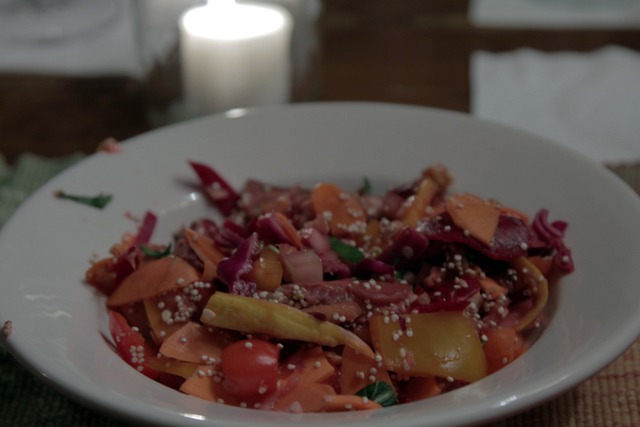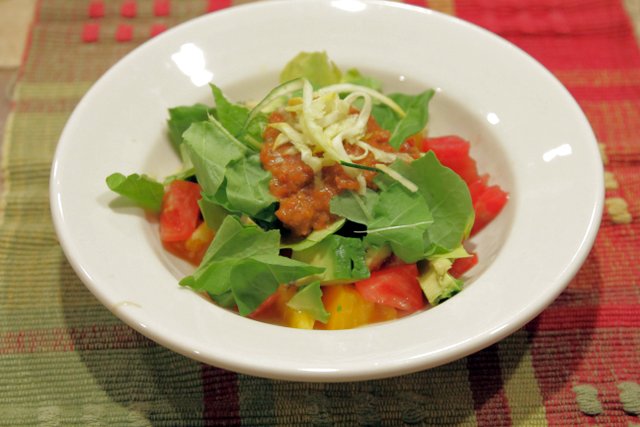Photography by Adam Croce

What the heck is healthy anyway? You’re confronted with contradicting scientific studies, sugar substitutes, gluten-free, vegan faux meats, diets diets diets. I personally spend more time reading the nutrition labels in the supermarket than I do actually eating the products. Things can get confusing!
Luckily, this is what I live for (besides spoofing The Real L Word, obvs). I’m not one to preach and push the vegan lifestyle, because I truly believe that everybody’s body has different nutritional needs and it is up to you to figure out what works for your own self. But I’ll definitely give you some basic tips that will hopefully help when you’re trying to decide how to structure your diet.
Michael Pollan has written a brilliant little book (and it comes in an illustrated version too!) called Food Rules. I suggest buying it, reading it, and sticking to the rules that resonate with you. Here are a few of my favorites:
Eat food. Not too much. Mostly plants.
If it came from a plant, eat it; if it was made in a plant, don’t.
Don’t eat anything your great grandmother wouldn’t recognize as food.
“Imagine your great-grandmother at your side as you roll down the aisles of the supermarket. You’re standing together in front of the dairy case. She picks up a package of Go-GURT Portable Yogurt tubes–and hasn’t a clue what this plastic cylinder of colored and flavored gel could possibly be. Is it a food or is it toothpaste? There are now thousands of foodish products in the supermarket that our ancestors simply wouldn’t recognize as food.”
If you are not hungry enough to eat an apple, then you are not hungry.
Simple, right? That’s how eating should be! Keep it simple.
Let’s move on to the topics of health and nutrition that spur the most heated debates! I fully expect you to scream your heart out in the comments. Just really get in there!
![]()
Foods to Avoid / Not Avoid
_
CARBS
Please for Gaia’s sake STOP CUTTING OUT CARBS. Carbohydrates are essential in the process of muscle building.
“Researchers found that low glycogen (carbs / sugar) levels impaired muscle protein synthesis following weight training. They measured the activity levels of genes controlling muscle growth following weight training in legs with normal or depleted levels of glycogen….Carbs fuel high-intensity exercise and stimulate the genes that control muscle growth.” According to the Journal Applied Physiology.
I don’t care if you’re on the Paleo Diet, Atkins, or South Beach — carbohydrates get such a bad rap, even though they’ve been around since our ancestors started eating. Brown rice, oatmeal, beans, fruits, vegetables — all these things contain carbs. It’s pretty much impossible to avoid carbs when eating. I think a better idea is to stay away from highly processed carbs, such as white bread, white flour, white anything. Actually, the only white thing in your diet should be cauliflower (and tofu or almond milk, in moderation).

PROTEIN
If one more person asks me how I get enough protein as a vegan…
Most people don’t know what “enough protein” actually is, as the meat and dairy industries have been the ones making these rules since the beginning of nutritional education. Recent studies are showing that:
“Muscle protein synthesis maxes out after a meal at 20-30 grams and anything in over will actually not help stimulate more muscle protein synthesis.” (A Moderate Serving of High-Quality Protein Maximally Stimulates Skeletal Muscle Protein Synthesis in Young and Elderly Subjects; Journal of the American Dietetic Association, Volume 109, Issue 9, Pages 1582-1586)
Wait, 20-30 grams!? I had a guy tell me this week that we should be eating 1 gram of protein for each pound we weigh, which is totally idiotic. I would have to eat a field of spinach a day for that many grams of protein. Luckily, I knew better. Guess what happens (especially to women) when you eat more protein than your body can synthesize: it turns to fat.
Oh, and if you’re still wondering, vegetarians and vegans get protein by eating vegetables, nuts, legumes, and grains. The aforementioned carry many of the amino acids that make up a full protein. We don’t need to eat all of the aminos that make up a full protein at every meal, we just need to eat different foods throughout the day.
Peanut butter and whole grain bread make a full protein, as do rice and beans. Hummus is also a full protein (beans and sesame seed paste). BAM.

SUGAR
This is a sticky subject [laugh]. My own personal rule is: don’t eat things with added sugars. I put this rule into practice by systematically break it on the daily. However! The main goal is to keep your sugar intake to a minimum. Sugars are really problematic when it comes to derailing our health plans, and while fats aren’t great for us either, it really comes down to our sugar intake. I try to get the majority of my sugar kicks from fruits, end of story. But I can’t seem to quit the almond milk in my morning coffee, so I let that one slide.
If you’re worried about your sugar intake, keep a running tally of the grams of (non-fruit based) sugar you consume throughout the day. Then try to cut that in half for the next month. Then try to cut that in half the month after that. Ideally, women shouldn’t be eating more than 25 grams of sugar per day. Eventually you will lose your addiction to sugar, which will make naturally sweet things — like fruit, and ladies — taste like an explosion of joy in your mouth.
Also, read the labels. Sugar is hiding in a lot of the foods we consume, and keeping it out of your diet will save you, on average, over 400 calories per day. While you’re at it, cut out the artificial sweeteners, too. This will really help wean your body off of its addiction to sweets.
FATS
Fats are confusing. Some fats are good, while others aren’t — kinda like your ex-girlfriends.
Good fats—monounsaturated and polyunsaturated fats—lower disease risk
Examples: fish, oils (from vegetables), seeds, nuts, nut butters, avocados, soy foods, and olives.
Bad fats—saturated and trans fats—increase disease risk
Examples: hydrogenated oils, dried coconut, coconut oil, butter, shortening, red meat, chicken (with skin), dark chocolate, dairy products (ALL), fried food, commercially baked pastries, and candy bars.
Essentially, if you’re eating high portions of meat and dairy in your diet,you’re eating a lot of bad fats. If you’re not in the market to go full-scale-veg, consider just scaling back on those types of foods and replacing them with vegetables and legumes.
![]()
For a Body That is Working Out
+
Food Tip #1: REFUEL
Always refuel within 45 minutes of a workout. Your body needs the nutrients it’s been depleting while working out. The best thing to refuel with is fast-digesting carbs, such as fruit and vegetables.
Food Tip #2: ADD COLOR TO YOUR LIFE
Eat as many colors as possible! A bowl of Lucky Charms doesn’t count, sorry. I’m talking bright yellows, reds, and greens that come from the earth. Put them on your plate and in your mouth. NOMS.

Food Tip #3: EAT BEFORE YOUR WORKOUT
If you’re working out later in the day, make sure you’ve a meal 2-3 hours before your workout. The meal should have a mix of carbs, protein (amino acids), and fats (the good ones, duh), such as a salad with hummus and avocado.
If you only have 15 to 30 minutes before a scheduled workout, pick a snack that is simple to digest. Specifically a snack that has about 25 grams of carbs, like a tablespoon of raisins, a banana, or a small serving of applesauce.
No matter what you do, make sure you’ve eaten something before your workout. You shouldn’t be training on an empty stomach.
![]()
Now it’s your turn to share your nutrition feelings in the comments! As usual, please keep in mind that this is a safe space for discussion and ideas, so keep it kosher (LOL SEE WHAT I DID THERE).
Disclaimer: Obvs this isn’t medical advice — this is just one person talking about eating whole foods for more energy. If you have questions about your personal nutrition, please speak to a healthcare professional.







